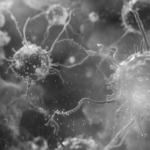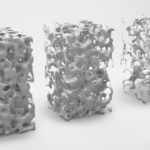
Immunology, Apple Cider Vinegar, and Grapefruit
A recent paper on sodium bicarbonate and blood cancer survival caught my eye yesterday (Uhl, et.al, 2020). To give some background, in patients with acute myeloid leukemia, there is a treatment that involves the transplant of blood derived stem cells (hematopoietic stem cell transplant (allo-HCT)). However, there is a certain unfortunate subset of these patients who relapse after this treatment and this is the major cause of death after the transplant, a very poor prognosis indeed. So why do they relapse?
As it happens, the patient’s leukemia tumor cells produce lactic acid which suppresses the transplanted T cells’ antitumor activity. The result is a failure of the stem cell transplant to kill off the tumor. Simply put, the tumor cells have learned how to neutralize the patient’s defenses with lactic acid, like a chemical warfare strategy. The lactic acid shuts down the process of making energy in the new T cell soldiers (by interfering with their glycolytic activity and oxidative phosphorylation) and it works like “pulling the plug on the droid.” Imagine the movie droid “powering down.” Another term for this effect is T Cell exhaustion.
Treatment of this lactic acid effect with sodium bicarbonate (alkalinization) reversed this effect of lactic acid.
T Cells and Immunology
To understand the impact of shutting down the T Cells, we need to understand what the T Cell does. It’s a type of white blood cell that is an immune soldier. One of these functions is immune-mediated cell death, and while there are several T cell types, this is carried out by two major subtypes: “killer” and “helper” T cells. The helper T’s (TH’s) start out by being “naïve” T’s and can morph into TH-1 or TH-2. TH-1 kill invaders by secreting inflammatory cytokines. We have all become familiar with this term ‘cytokine storm’ during this pandemic. TH-2 kill viruses and bacteria by influencing B lymphocytes to make antibodies, which are much less inflammatory. That’s how these vaccines work. T cells are immune soldiers.
For an entertaining presentation on this, please read my illustrated ‘bedtime story’ about BADASS V (https://drlewisclarke.com/the-cytokine-storm/).
So back to sodium bicarbonate and lactic acid. In patients with prolonged or severe infection (sepsis) the body becomes increasingly acidic. Doctors even measure lactic acid levels, especially during this pandemic. It is likely that the T cell exhaustion produced by these infections, cancers, and transplants all have in common a lactic acid shut down of T cell function, neutralizing the body’s defenses.
Apple Cider Vinegar (ACV) and Grapefruit
All that to say that alkalinization can be accomplished in some very simple ways in our bodies. I’ll give two examples, Vinegar and Grapefruit. You ask, “Why, Apple Cider Vinegar and Grapefruit?” Then I hear you saying, “Wait a minute. These are both VERY acidic. They should be shutting down the T Cells just like lactic acid.” And yes, that would seem to be the case. However, while these are both acids (and your stomach will most certainly confirm it), surprisingly, they both ultimately have alkalinizing effects on the body (Honow et. al. 2003; Murunga et.al. 2016) Exactly how this happens lies hidden away in the mysterious Citric Acid Cycle, the bane of all first-year medical students, and thankfully not the focus of this writing.
To the point, immunologic benefits may be direct, by their phenolic nature (phenols kill everything), or indirect by virtue of the alkalinization produced by ACV and Grapefruit. And not surprisingly, these are both antibacterial against MRSA, resistant E-coli, candida fungal infections, (Darshna, et. al. 2021; Darshna, et.al 2018; Gopal, et.al. 2019) as well as viral infections (Massimo, et.al. 2006; Khan, et.al, 2020). Equally interesting is that they attenuate the cytokine storm by the TH-1 T cell cascade and promote antibody production via TH-2 acquired adaptive system. Clearly these effects must be partly due to the promotion of an alkaline state by these acids, “preventing droid powerdown” by lactic acid and maintaining good immunologic soldiers.
Other Alkalinizing Benefits of ACV and Grapefruit
We already know that bicarbonate water decreases urinary calcium oxalate kidney stones by at least one mechanism of citrate (acid) excretion (Karagulle, et al. 2007). Grapefruit and its juices have the same effect (Trinchieri et. al.2002; Honow et.al, 2003) by its alkalinizing effect on the urine and it is proposed that there is similar benefit in treatment of stage III renal disease by virtue of its reversal of metabolic acidosis (Siener 2018). Asejeje et al. (2020) had similar results with ACV..
Both ACV and Grapefruit increase bone density and quality (Deyhim, et.al. 2008). The mechanism for this is elegant. The depletion of calcium from bone is partly the result of the excessively acidic state of the body’s cells. When carbohydrate/sugar is consumed, it increases the glucose in your cells. Excessive glucose levels, through a complex process, result in your body’s cellular milleu becoming more acidic. The body does not like that at all and it mobilizes calcium and magnesium from the bone matrix to decrease the acidity, ultimately excreting these minerals in the urine. So, it sucks out calcium from the bone to serve as an antacid. Calcium is leeched from the bone in an attempt to neutralize the acids. Providing a buffer with alkalinization by ACV and Grapefruit likely plays a role in preventing bone loss.
With regard to this glucose issue, both acids improve lipid profiles, lower HbA1C, decrease insulin resistance and metabolic syndrome (Murunga et.al. 2016), and even promote weight loss (1.5 kg. in 12 weeks in a controlled study) (Fujioka, et. al 2006; Shishehbor, et.al, 2008). Most patients will report a decrease in abdominal bloating.
There are many more well-designed studies of the varied and ubiquitous biochemical mechanisms of these beneficial bioactive acids including purported tumor prevention and adjunctive treatment with ACV and Grapefruit and their derivatives (Hermann, et.al., 2002). My current preoccupation, though, initiated by viral pandemics, is with the immunochemistry which is why the paper on leukemia caught my eye.
CAUTION HOWEVER
Grapefruit can prevent the breakdown or metabolism of some important drugs via its CYP-3A4 competition. These medications will then not be metabolized at the expected rate and can cause some significant problems with higher than expected levels. Calcium channel blockers for blood pressure and arrhythmias, tadalafil, statins, some opioids to name a few. All medications can be researched easily online to see if they are extensively metabolized by CYP-3A4. If not, then grapefruit should cause no such problem.
REFERENCES
Judy Gopal, Vimala Anthonydhason, Manikandan Muthu, Enkhtaivan Gansukh, Somang Jung, Sechul Chul, Sivanesan Iyyakkannu; Nat Prod Res 2019 Mar;33(6):906-910
O Karagülle, U Smorag, F Candir, G Gundermann, U Jonas, A J Becker, A Gehrke, C Gutenbrunner; World J Urol 2007 Jun;25(3):315-23.
Ruth Hönow, Norbert Laube, Anke Schneider, Torsten Kessler, Albrecht Hesse; Br J Nutr 2003 Aug;90(2):295-300.
A Trinchieri, R Lizzano, P Bernardini, M Nicola, F Pozzoni, A L Romano, M P Serrago, S Confalanieri; Dig Liver Dis 2002 Sep;34 Suppl 2:S160-3.
Roswitha Siener, Nutrients 2018 Apr 20;10(4):512.
Farzad Deyhim,Kranthi Mandadi, Bahram Faraji, Bhimanagouda S Patil; J Med Food 2008 Mar;11(1):99-104.
Ken Fujioka, Frank Greenway, Judy Sheard, Yu Ying; J Med Food Spring 2006;9(1):49-54.
F Shishehbor, A Mansoori, A R Sarkaki, M T Jalali, S M Latifi; Pak J Biol Sci 2008 Dec 1;11(23):2634-8.
Bianca N. Quade, Mark D. Parker, Rossana Occhipintid; The therapeutic importance of acid-base balance; Biochem Pharmacol. 2021 Jan; 183.
F O Asejeje, O M Ighodaro, G I Asejeje, A M Adeosun; Metabol Open 2020 Sep 30;8:100063.
Darshna Yagnik, Malcolm Ward, Ajit J Shah; Sci Rep. 2021 Jan 20;11(1):1854.
Darshna Yagnik, Vlad Serafin, Ajit J Shah; Sci Rep 2018 Jan 29;8(1):1732.
Franziska Maria Uhl, Sophia Chen, David O’Sullivan, Joy Edwards-Hicks; Metabolic reprogramming of donor T cells enhances graft-versus-leukemia effects in mice and humans; Science Translational Medicine 12(567): eabb8969. October 2020
M Hermann, A Asberg, J L E Reubsaet, S Sather, K J Berg, H Christensen Int J Clin Pharmacol Ther 2002 Oct;40(10):451-6.
Alfred N. Murunga, David O. Miruka, Christine Driver, Fezile S. Nkomo, Snazo Z. Z. Cobongela, and Peter M. O. Owira; Grapefruit Derived Flavonoid Naringin Improves Ketoacidosis and Lipid Peroxidation in Type 1 Diabetes Rat Model; PLoS One. 2016; 11(4): e0153241.
Massimo Curini 1 , Giancarlo Cravotto, Francesco Epifano, Giovanni Giannone; Curr Med Chem 2006;13(2):199-222.
Mahim Khan, Waqar Rauf, Fazal-E- Habib, Moazur Rahman, Mazhar Iqbal; World J Hepatol 2020 Nov 27;12(11):976-992.

